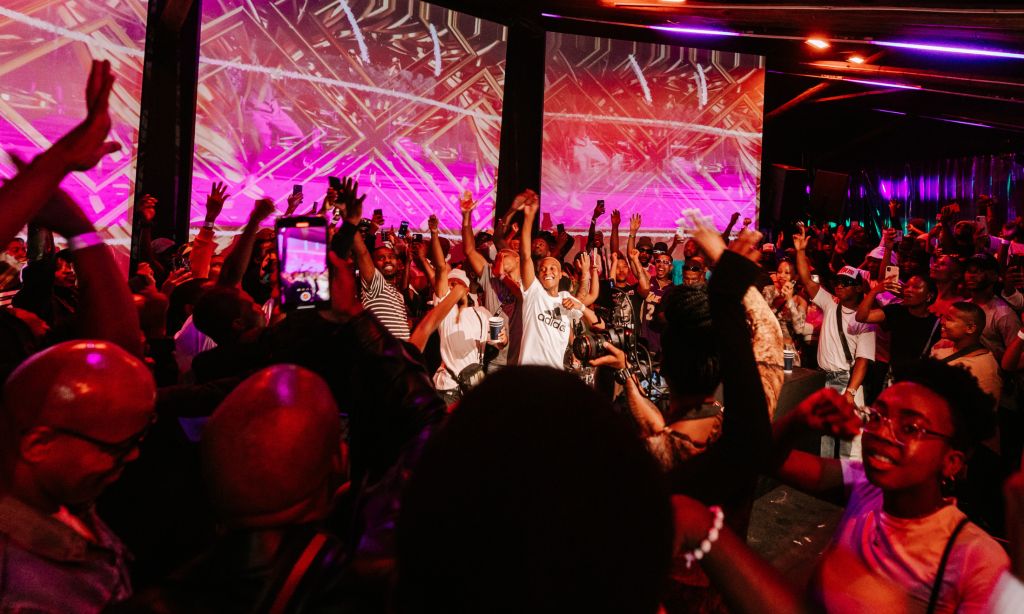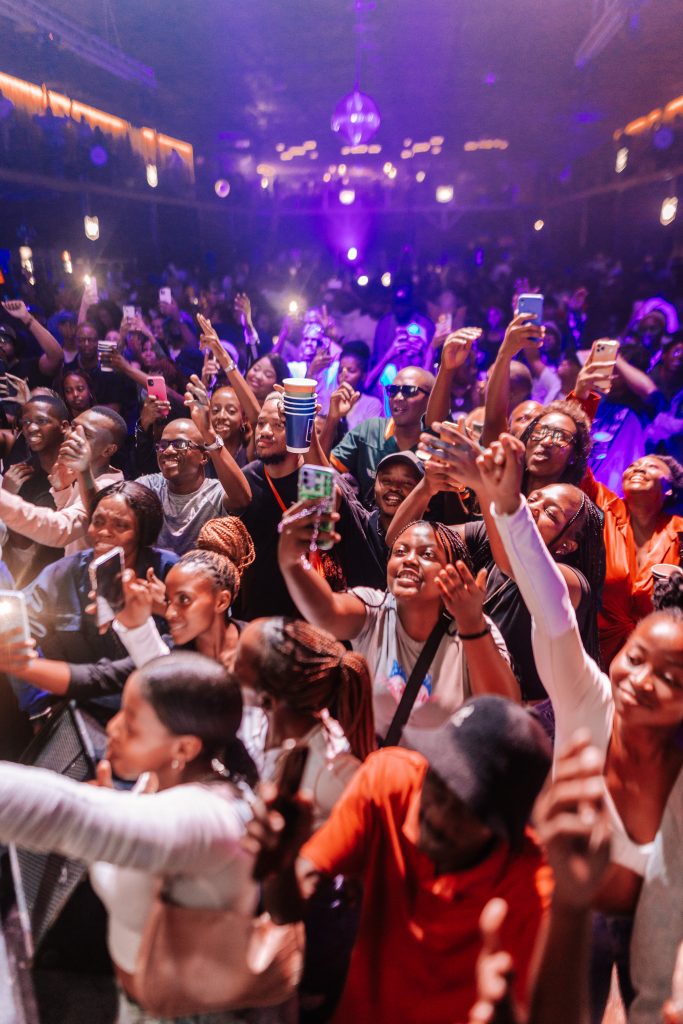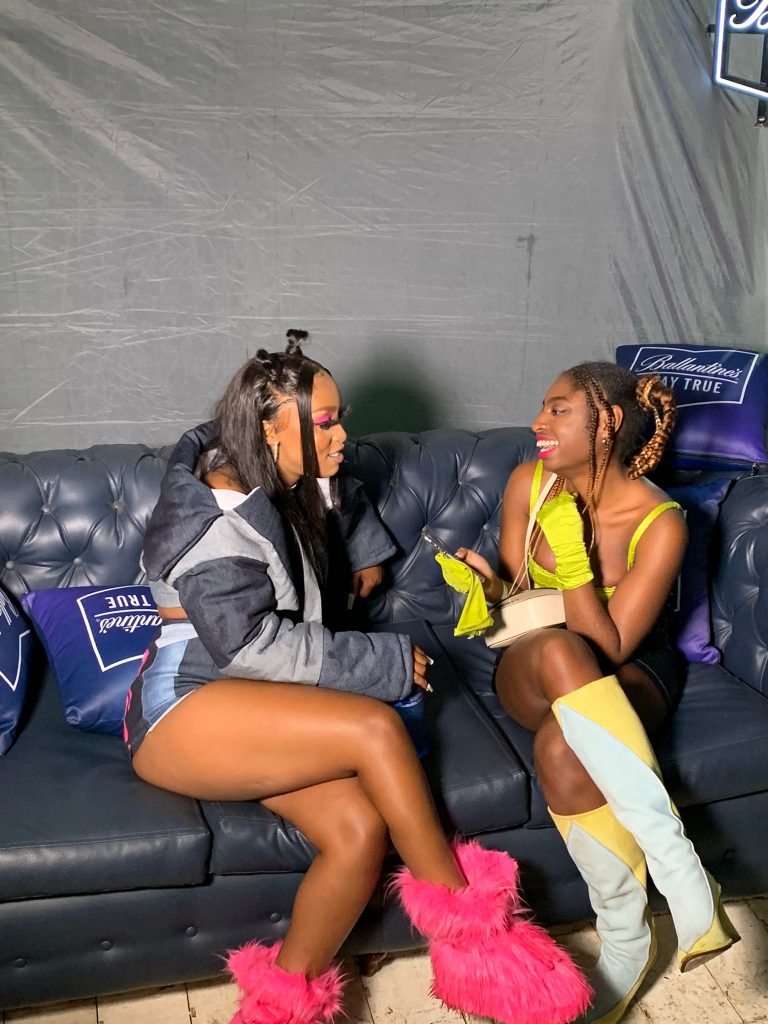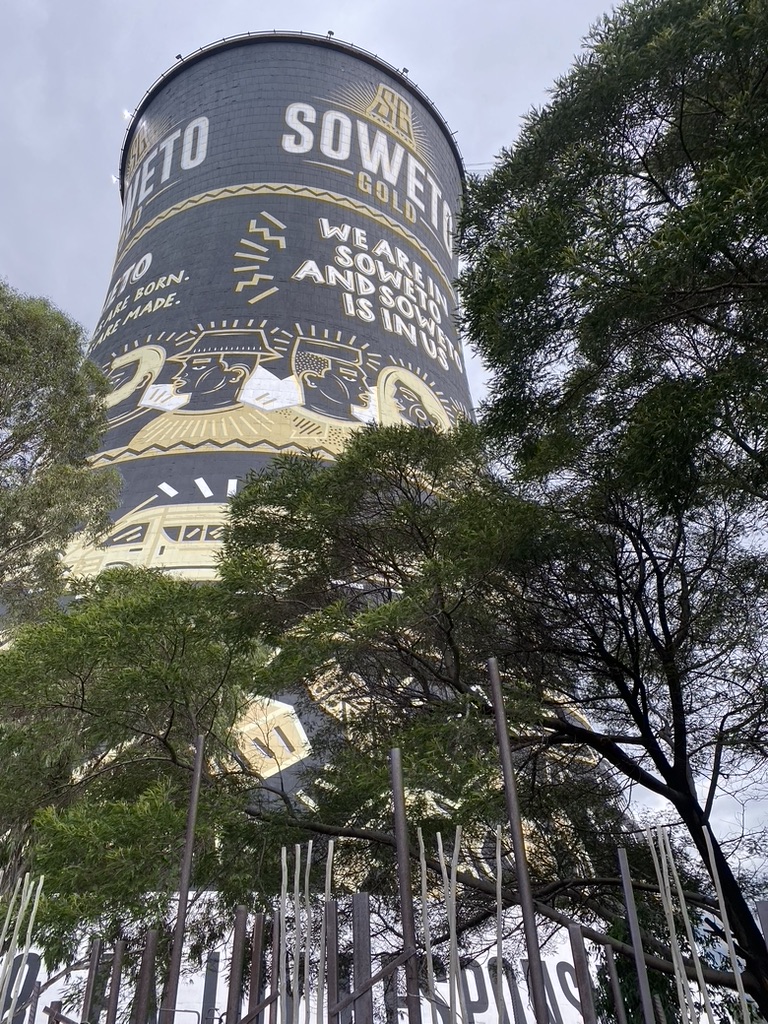The two defunct cooling towers of Chaf Pozi punctuate the landscape, exclaiming to those who are approaching the area that they have arrived in Soweto. It’s a densely populated and sprawling township – a racially-segregated urban neighbourhood – which effectively became South Africa’s largest Black city. It’s home to distinct cultures, and rebellious uprisings and once housed Nelson Mandela and Desmond Tutu. Though there are clouds rolling above, and the red earth has softened due to recent flash showers, revellers’ moods are buoyant. “Nights don’t end early here. You can come to the afterparty with us in the hood,” a girl says to me as we walk from the toilets to the crowded dancefloor.
It’s a running theme of my night, and actually my entire time in Johannesburg, that to really experience South African dance genres like amapiano, gqom (pronounced “gom” but with a click), bacardi and kwaito, you must be willing to travel off the beaten path. “Amapiano is hood,” says Kamo Mphela, a local superstar who has garnered over 450,000 monthly streams on Spotify. “When you go to the hood, that’s where you get the true experience of the sound and the passion from the people.” This is why, as part of their global spotlight on music scenes to support and invest in the diverse range of talent, Boiler Room and Ballantine’s chose to program True Music Studios in Soweto (a portmanteau of southwestern townships), thought to be the genesis of this sound. gal-dem was invited as a guest to the festival, comprising almost a week of events to join the whisky and nightlife titans in a quest for authenticity and to bolster the names shaping the scene on the ground.
One of my personal goals as a storyteller with an interest in youth culture is to regularly travel to, learn more about, and then report on Africa. Why? It has the youngest population in the world. Right now, 70% of sub-Saharan Africa is under 30. The direct impact of that is an unrivalled energy, a new crop of tastemakers with a drive to innovate, and to push the possibilities of where the continent can go next. That is palpable in its musical rebirth. Apple Music reported a 500% overall streaming increase for African DJ mixes between August 2021 and August 2022. South African genres like amapiano are dominating dance music and soundtracked our dancefloor reunions in clubs after the lockdown lifted in the UK. DJs started mixing amapiano into their festival sets, Notting Hill Carnival set up its first-ever amapiano stage last year, the sound has been interpreted by Wizkid and Jorja Smith and viral Tik Tok dance crazes have chauffeured amapiano far and wide. While the earlier sound was characterised by jazz-infused high-pitched piano, it has morphed into an electronic force with a pounding log drum and local languages, ululations and ad-libs.

Throughout the week, we see lots of synchronised dancing to DJ sets, learn some of the hottest dance moves by Kamo Mphela, marvel at the vocals (and bone structure) of Daliwonga, one of the scene’s most revered vocalists, and journey to Zone 6, a huge club owned by legendary South African house DJ Black Coffee. Tucked away down a blocked-off road in the belly of Soweto, we catch a well-choreographed set by the impeccably dressed Uncle Waffles to understand how she made it onto the Coachella lineup and why Drake became such a fanboy of her. (He has posted about her numerous times on Instagram and then dropped the slightly weird lyric – “If I was your favourite uncle, I’d buy you waffles every time you waddle outta my castle” on Honestly, Nevermind – sparking further rumours). But among all the partying, a conversation between Mpumelelo ‘Frypan’ Mfula and an intergenerational spread of electronic musicians from South Africa about how the township has powered musical innovation really stuck with me.
As an outsider, the country’s recent history is characterised by a struggle as to who gets to define what South Africa is. The burgeoning nightlife scene stands in defiance of restrictions once seen under apartheid, where large black gatherings were prohibited. There was also a ban on natives drinking hard liquor – pushing them to drink either state-brewed beer or homebrewed moonshine. So partying, enjoying, and creating space for community is a political act.
Frypan discussed how despite these restrictions and the emotional and economic scars left by them in the townships, black people persisted. In the 1980s bubblegum, a local form of disco provided a sonic backdrop to the anti-apartheid struggle. The 1990s and noughties saw the rise of kwaito, a variant of house during a period of huge political change with Mandela becoming the country’s first Black leader. Some songs expressed feelings of freedom, and others used the freedom to talk frankly about their daily lives. The latter resonates with Nkosi Zuthulele from afro-psychedelic band Bantu Continua Uhuru Consciousness (BCUC) who says: “I grew up with music that was underground that never intended to be mainstream but always intended to be a staple of our make-up.” In the middle of the 2010s, the Africanisation of Chicago house music they had heard on the radio continued, blending it with traditional sounds and influences from Kwaito and beyond, which led to South Africa becoming the biggest market for house music per capita globally.
“It’s been a really crazy experience of being in the amapiano scene and allowing us to dream big, and bigger than the borders of South Africa.”
Frypan and Lady Sakhe reminisced on the prevalence of “bunkers”, which are parties organised by those skipping school, as a way of connecting young black music lovers to these underground scenes. “A group of some friends, some of them lived in Soweto and some in the East Rand, were looking for a way to get together somehow,” explains Lady Sakhe. They played the music you didn’t hear on the radio and sounds they could only buy in record stores. “It spread like wildfire. By the third party, the cops came because we weren’t supposed to make noise. It was like reliving what happened before [during apartheid] but we were just school kids.”
Out of these dynamic homegrown electronic scenes sprung up new sounds like afro tech, bacardi and amapiano. This is where we get artists like Kamo Mphela whose club anthems and expert choreography (“Dance is a big role. You need to influence the younger generation to move”), have made her a leading name in the country’s growing music industry. Her dexterity within the scene has spawned countless social media dance challenges and recently earned her a spot on the Black Panther: Wakanda Forever soundtrack. “It was so inspiring to see an opportunity like that to come to South Africans for us to shine with our own sound,” she explains. She sings predominantly in Zulu, which was considered inferior to English and Afrikaans during apartheid. Now even though her international audience may not understand it, that same downtrodden dialect sees her sharing stages with the likes of 50 Cent, Little Simz and more. “I’m just a girl from Soweto who’s actually now able to speak my own language, show my own South Africa, ah it’s just priceless,” she says.
Kamo Mphela continues: “It’s been a really crazy experience of being in the amapiano scene and just seeing how much influence you also have on the genre growing and allowing us to dream big, bigger than the borders of South Africa.”
Other so-called ‘world genres’ like reggaeton and dancehall have found that the originators of the sound don’t always get the kudos or cash they deserve. However, a legend of the scene, Njelic, is keen to shout out who he sees as pioneers of the South African dance scene from Nkosi Zuthulele (a member of BCUC) to Kabza De Small and MFR Souls. Kamo Mphela adds that those who want to tap into the genre need in any real way need to search for the talent around her on home soil. “People can make something that sounds like it but it’s not the same,” she says. “You can be influenced, but as much as it can be commercialised, I think people want to understand where it really comes from.”
She recommends those who land in Johannesburg check out spaces like Makubenjalo, Urban Grill, Konka, and [Party in] Tanzania. “I’m just gonna name all the spots that are in the dungeons where you get the coolest kids.”
True Music Studios also sought to highlight parties on the fringes, finishing on a high-octane vogue ballroom lineup with Le Grand Brand. While other African nations like Ghana and Uganda propose and pass fresh homophobic legislation, South Africa’s queer scene is visible on billboards around the city. On the final night of Ballantine’s and Boiler Room’s collaboration, four houses competed: Pose, Money, Queer Mafia, and Stars. Bodies contorted, looks were served, and one contestant defiantly slapped their ass cheeks in a judge’s face to disagree with their score. The night finished with Gqom girl LIKKYLIKS and a hypnotic set by DJ Le Soul. Gqom is an onomatopoeic word derived from Zulu for the sound of hitting a drum. It’s all at once ancestral and industrial. Its place on the LGBTQIA-focused closing night was due to its prevalence in queer spaces: its style and beat fit the dance-offs, posing and strutting while being a symbol of counter-culture.
“For me, my favourite spaces are the ones where I find the most black people, happy and free.”
Speaking to the members of House of Stars, they wax lyrical about the genre, one dancer calls it “African punk”. “It’s hardcore, very metallic, and it makes me feel alive,” they say, before asserting you’re more likely to hear it in Durban, Cape Town or Montana (in Pretoria). “You can hear it in Sumo on a Sunday [in Johannesburg].”
Still, Mandima Qunta, the mother and founder of Le Grand Brand, finds herself more comfortable on nights in Soweto: “For me, my favourite spaces are the ones where I find the most black people, happy and free.” While that may feel like an odd statement for an African club scene, on one of our after-party detours around the city we ended up at a techno club in the CBD where there were no more than a handful of black people but an abundance of white men with their shirts off. Soweto’s journey from a township to a black autonomous city in its own right should be an inspiration to other townships around the country where life expectancy in townships where little has changed in economic terms since apartheid. Helping it become the centre of music, dance, and culture – affording opportunities to its naturally talented youth – is an inherent win for black South Africans.
On one of the nights I met Jakinda Boya, who is part of the renegade musical duo Stiff Pap (named after a local mashed potato-like dish) and has been throwing parties with the Ebumnandini collective since 2019 from Cape Town to Johannesburg, crafting a space for “left field” artists. He says he was influenced by Boiler Room to create a platform that stood in opposition to the aspirational bottle service club scene that has formed around amapiano. “South African music is popular overseas now, but it’s frustrating if people only look to us for one genre,” he says. Though amapiano has underground roots, it has now become mainstream. Given this, Jakinda tries to book people who don’t get jobs because their sounds are more experimental or aren’t popular now the airwaves are dominated by amapiano. And the night attracts party guests who are daring sartorially, have wide music tastes, more liberal ideals, and are queer or gender non-conforming.

Speaking to him, it’s clear you can’t really talk in-depth about South Africa’s current scene without looking at the politics of the country and amplifying the voices of the young people who were promised a freer society and find themselves constricted by its everyday struggles.
I share with him how excited I’ve been to travel the continent. He says he’s heard similar things from other travellers who are jealous because he lives “in the motherland”, the home of humanity and a Black nation. “But I don’t think people know how hard it is to just be here on a regular basis, sometimes there won’t be any power for half the day every single day,” he says. “People should come here and see it definitely, it’s a beautiful country, and you will have a great time. But don’t come with an idealised version of us, don’t come with a colonial attitude, or think about how cheap it is. Think about the people here.”
While Africa is a young continent and that means there is a lot of talent to be harnessed to decide its future, currently youth unemployment stands at 63.9% for those under 24. Music is an outlet for their energy.
Jakinda explains: “South Africa is on a downward spiral right now. For the youth, it’s really bleak. My music expresses the perspective of being a young artist navigating South Africa during this time in a country that doesn’t respect what you do, and a government spitting in your face. I’m rebelling against what South Africans should sound like, I’m rebelling against the South African dream that’s been advertised about this ‘rainbow nation’.”
(L) Kemi interviews Kamo Mphela (R) One of the towers at Chaf Pozi





